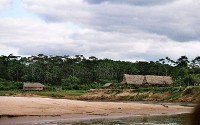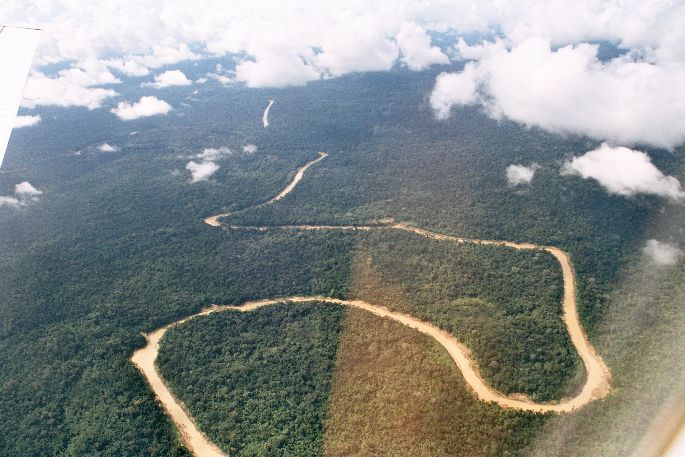
Vista aérea do rio Purus/ Brasil (Camargo 2006)
Os caxinauás vivem na Amazônia ocidental, na região fronteiriça entre o Brasil e o Peru, área coberta de morros e floresta tropical. Durante a época de chuva, de outubro a abril, a água nos rios sobe até seis metros acima do nível médio na época de seca. Caracterizado por serem formados de meandros fortes, os rios dessa região mudam freqüentemente de curso, formando lagoas no curso anterior. No final da época de seca, entre maio e setembro, a navegação se torna muitas vezes difícil em algumas partes do rio por causa do nível de água bastante baixo. Os habitantes dessa região são continuamente atacados por insetos, inclusive o mosquito transmissor da malária.
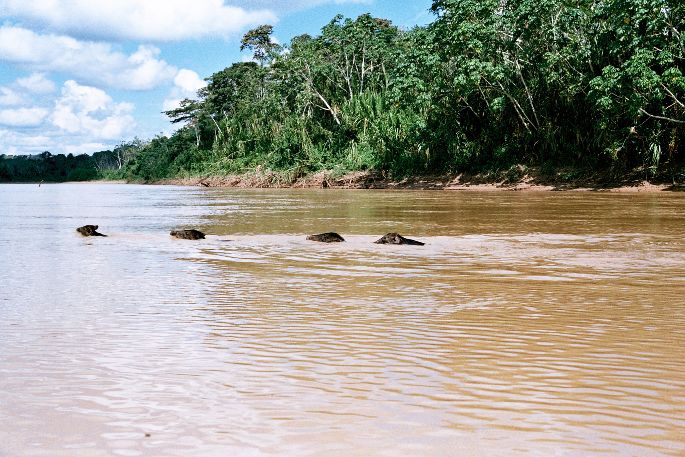
Grupo de caititus atravessando o rio Purus/ Peru (© Camargo 2006)
Segundo Aquino/Iglesias (2002:147), o grupo caxinauá detém a maior população indígena no Estado do Acre, onde vive ao longo dos rios na bacia do Juruá (Tarauacá, Jordão, Breu, Muru, Envira, Humaitá) e na bacia do rio Purus.
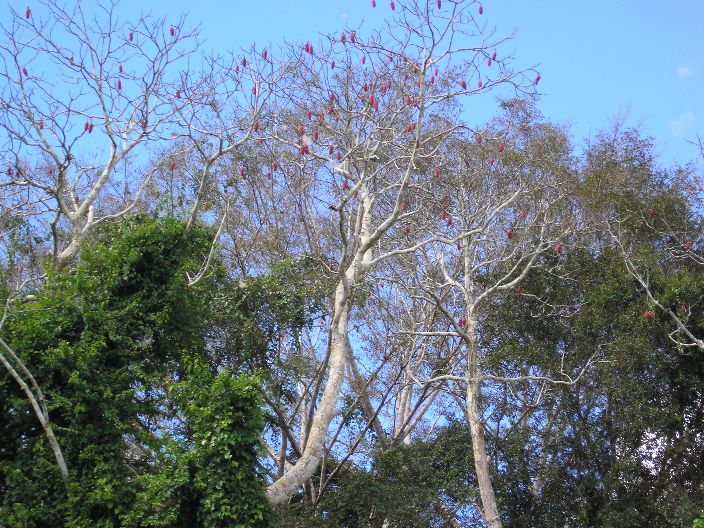
Árvores do lado do rio Tarauacá/ Brasil (© Camargo 2006)
As aldeias caxinauás no Peru localizam-se ao longo do alto rio Purus e seu afluente Curanja. Não há um censo exato da população e falantes caxinauás, neste quesito os dados disponíveis na literatura referente não são muito coerentes.
A população indígena total do Estado do Acre varia consideravelmente ao comparar aos dados fornecidos pelo ISA (Instituto Socioambiental), FUNAI (Fundação Nacional do Indio) e IBGE (Instituto Brasileiro de Geografia e Estatística) (cf. http://pib.socioambiental.org/pt/c/no-brasil-atual/quantos-sao/diferentes-estimativas). Aquino & Iglesias (2002) declaram uma população de aproximadamente 4.000 caxinauás brasileiros que vivem em doze terras indígenas. Em um censo interno mais recente (abril 2006) registra-se 5.738 indivíduos. Segundo o ISA, os caxinauás do Brasil compartilham quatro das doze áreas com grupos da mesma família lingüística e com grupos de outras famílias: no rio Purus, eles dividem seu território com os iaminauás (P) e culinas/madiha (Arauá), no rio Envira com os catuquinas (P) e xanenauás (P), e nos rios Humaitá e Breu com os campas/axanincas (Arauaque). Dez dessas áreas são homologadas, uma delas está em identificação, uma outra ainda não está completamente regularizada (essas duas áreas são antigos seringais).
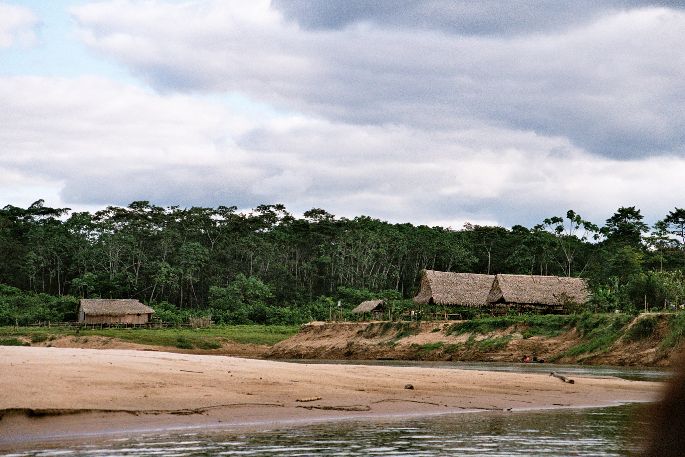
Aldeia caxinauá no rio Tarauacá (© Camargo 2006)
Conseguir informações sobre o número global de aldeias caxinauás no Acre não é nada fácil; novas aldeias são formadas com freqüência.
Em um censo interno realizado, de março de 2006, na Área indígena da Praia do Carapanã, globalmente esta era composta de 599 pessoas entre sete (ou oito) aldeias, sendo que cada abrigava entre 18 a 161 habitantes. Para esta mesma área, em 1999 a CPI-Acre levantou 246 pessoas (dado citado no ISA 2004). Esta contagem não leva em conta as 535 pessoas que formam o “grupo Apuanã” ainda não reconhecido oficialmente. De qualquer forma, o aumento de população dentro de uma área específica geralmente é o resultado de uma migração interna. Para McCallum (1989), nos anos 80 a população geral era composta de pelo menos de 2.200 pessoas; dado que, visto a população atual, leva a concluir que esse grupo pano esteja aumentando consideravelmente no Brasil.
Obter o censo da população caxinauá geral no Peru traduz-se ser uma tarefa difícil: baseado no censo de 1993, Kensinger (1998:108) fornece o número de 1.219 pessoas, população que em dez anos atingiu a casa de pelo menos 1.600 (Gordon 2005), junto com 400 falantes no Brasil. Este número contrasta com os 5.000 membros deste grupo pano. Baseando-se ainda no censo brasileiro de 1999 e no peruano de 2000, Ricardo (2000:12) lista 3.964 caxinauá no Brasil e 1.400 no Peru. O cruzamento das diferentes fontes aponta uma população de 5.400 caxinauás. Quando as aldeias caxinauás não dispõem de um censo preciso a base é feita somente sob estimativas. No Peru, Kensinger (1998: mapa 1, p. 8/9, e tabela 1, p.108) assinala entre 12 e 13 aldeias. A aldeia de San Martin, fundada em 1996 e na qual a equipe DoBeS sediou seu trabalho em 2006, não consta em sua lista. Isto mostra a pouca fiabilidade destes dados. Além disso, Kensinger (1998: 13) informa que houve um aumento demográfico considerável no grupo peruano durante os últimos 50 anos; a melhora da assistência médica foi um fator fundamental para a diminuição da mortalidade infantil. Se no Brasil, as comunidades caxinauás estão dentro de terras ou reservas demarcadas, no Peru, todas as comunidades receberam em 1994 títulos de suas terras (Kensinger 1998:13), e com isso o chefe da aldeia tem autonomia para vender a parte relativa à sua aldeia.
Bibliografia:
Aquino, Terri Valle de & Marcelo Piedrafita Iglesias (2002). “Habitantes: Os Kaxinawá”. Em: Carneiro da Cunha, Manuela & Mauro Barbosa de Almeida (eds.). Enciclopédia da floresta. O alto juruá: práticas e conhecimentos das populações. São Paulo: Companhia das Letras, 147-160.
Ricardo, Carlos Alberto (2000) (ed.). Povos Indígenas no Brasil, 1996-2000. São Paulo: Instituto Socioambiental.

